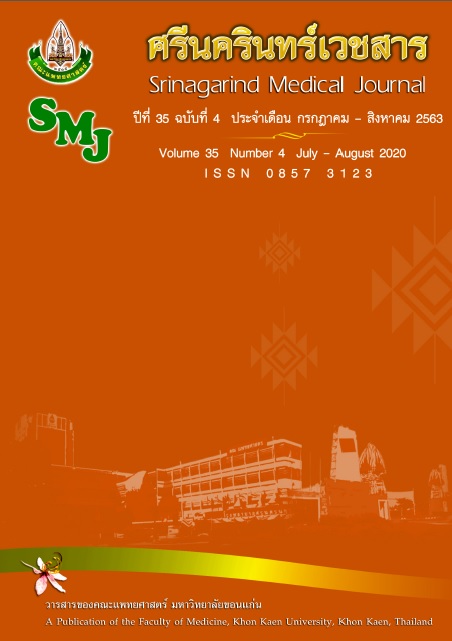Effects of a 2-week Home-Based Strength Training Associated with Task-Oriented Training to Upper Limb Function Activities in Patients with Chronic Stroke
Abstract
ผลของการฝึกความแข็งแรงร่วมกับการฝึกกิจกรรมอย่างมีเป้าหมายที่บ้านเป็นเวลา 2 สัปดาห์ต่อการทำงานของรยางค์ส่วนบนในผู้ป่วยโรคหลอดเลือดสมองระยะเรื้อรัง
โอฬาร อิสริยะพันธุ์1,2, จีราวรรณ เกิดสวัสดิ์มงคล1,2, ณัฐชยา ชนแดน1,2, น้อมจิตต์ นวลเนตร์3,4,5, ดวงนภา รุ่งพิบูลโสภิษฐ์6, วรุณนภา ศรีโสภาพ1,2*
1ภาควิชากายภาพบำบัด คณะสหเวชศาสตร์ มหาวิทยาลัยนเรศวร จังหวัดพิษณุโลก
2หน่วยวิจัยวิทยาศาสตร์การออกกำลังกายและการฟื้นฟู ภาควิชากายภาพบำบัด คณะสหเวชศาสตร์ มหาวิทยาลัยนเรศวร จังหวัดพิษณุโลก
3สาขาวิชากายภาพบำบัด คณะเทคนิคการแพทย์ มหาวิทยาลัยขอนแก่น
4กลุ่มวิจัยโรคหลอดเลือดสมอง ภาคตะวันออกเฉียงเหนือ คณะแพทยศาสตร์ มหาวิทยาลัยขอนแก่น
5ศูนย์วิจัยและเพื่อฝึกอบรมเพื่อส่งเสริมคณุภาพชีวิตคนวัยแรงงาน มหาวิทยาลัยขอนแก่น
6หน่วยประสาทวิทยา ภาควิชาอายุรศาสตร์ คณะแพทยศาสตร์ มหาวิทยาลัยนเรศวร จังหวัดพิษณุโลก
หลักการและวัตถุประสงค์: การอ่อนแรงของกล้ามเนื้อเป็นสาเหตุหลักของการจำกัดการทำงานของรยางค์ส่วนบนในผู้ป่วยโรคหลอดเลือดสมอง การฝึกกิจกรรมอย่างมีเป้าหมาย (task-oriented training: TOT) และการฝึกความแข็งแรงอาจฟื้นฟูการทำงานของรยางค์ส่วนบนได้ การศึกษาครั้งนี้มีวัตถุประสงค์เพื่อศึกษาผลการฝึกความแข็งแรงร่วมกับ TOT (strength training associated with TOT: ST_TOT) ในผู้ป่วยโรคหลอดเลือดสมองระยะเรื้อรัง
วิธีการศึกษา: การศึกษานี้เป็นการทดลองแบบสุ่มและมีกลุ่มควบคุม โดยปกปิดสองทาง อาสาสมัคร 20 ราย ถูกสุ่มเข้ากลุ่ม ST_TOT และกลุ่ม TOT กลุ่มละ 10 ราย ได้รับการฝึกที่บ้าน ครั้งละ 70 นาที 5 วัน/สัปดาห์ 2 สัปดาห์ ประเมินการทำงานของรยางค์ส่วนบน ความแข็งแรงของกล้ามเนื้อกำมือ และการเกร็งตัวของกล้ามเนื้อ ด้วย The Streamlined Wolf Motor Function test-chronic (SWMFT-C), Hand grip dynamometer (HG) และ Modified Ashworth Scale (MAS) ตามลำดับ
ผลการศึกษา: หลังฝึก 2 สัปดาห์ พบว่า กลุ่ม ST_TOT มีคะแนน SWMFT-C และค่า HG ดีขึ้นอย่างมีนัยสำคัญทางสถิติ (p<0.05) โดยค่า MAS ไม่เพิ่ม และไม่พบความแตกต่างอย่างมีนัยสำคัญทางสถิติเมื่อเทียบตัวแปรในกลุ่ม TOT และระหว่างกลุ่ม
สรุป: การฝึกความแข็งแรงร่วมกับการฝึกกิจกรรมอย่างมีเป้าหมายที่บ้านในผู้ป่วยโรคหลอดเลือดสมองระยะเรื้อรังเป็นเวลา 2 สัปดาห์ ส่งผลให้การทำงานของรยางค์ส่วนบน และความแข็งแรงของกล้ามเนื้อกำมือเพิ่มขึ้น
คำสำคัญ: โรคหลอดเลือดสมอง; การฝึกกิจกรรมอย่างมีเป้าหมาย; การทำงานของรยางค์ส่วนบน; ความแข็งแรงของกล้ามเนื้อ; การเกร็งตัวของกล้ามเนื้อ
Abstract
Background and objective: Muscle weakness is the main cause of upper limb function activities (ULFA) dysfunction, which is commonly found in stroke patients. Task-oriented training (TOT) and strengthening programs may improve ULFA. The purpose of this study was to investigate the effects of adding strength training to TOT in chronic stroke.
Methods: A double blind, randomized controlled trial was conducted. Twenty chronic stroke patients were allocated to either home-based personalized strength training added to TOT (ST_TOT group, n=10) or TOT (TOT group, n=10). The participants in both groups received individualized training for 70 minutes, 5 times/week for a period of 2 weeks. Upper limb function, hand grip strength, and muscle tone were assessed by The Streamlined Wolf Motor Function test (chronic) (SWMFT-C), Hand grip dynamometer and Modified Ashworth Scale, respectively.
Results: At the end of the 2-week training phase, the ST_TOT group showed statistically significant improvement in both SWMFT-C and hand grip strength (p<0.05), without any increase of muscle tone. No statistically significant differences were seen in the TOT group. However, when compared with between group were not statistically significant.
Conclusion: Adding strength training to task-oriented training in patients with chronic stroke had statistically significant beneficial effects on ULFA and hand grip strength in 2 weeks
Keywords: Stroke; Task-Oriented Training; Upper Limb Functional Activities; Muscle Strength; Muscle Tone


